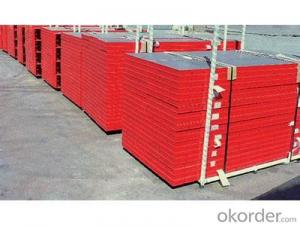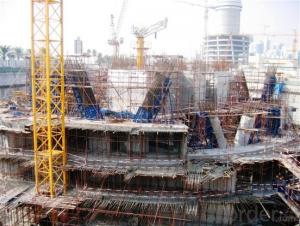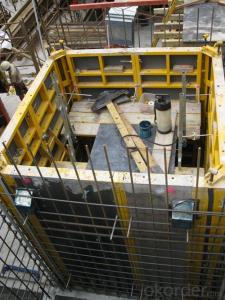Table formwork system for Build
- Loading Port:
- China Main Port
- Payment Terms:
- TT OR LC
- Min Order Qty:
- -
- Supply Capability:
- -
OKorder Service Pledge
Quality Product, Order Online Tracking, Timely Delivery
OKorder Financial Service
Credit Rating, Credit Services, Credit Purchasing
You Might Also Like
Tabel Formwork:
Table formwork is the most typical application for slab, with timber beam, the slab formwork is
light weight, fast and economic in the construction.
Characteristics:
◆ Simple structure, easy assembly.
◆ Flexible structure, be adapted to different support system.
◆ High construction efficiency with special system tools.
1. Lifting fork for lifting the table formwork to upper floor.
2. Trolley for moving the table formwork on floor.
◆ Flexible application with stand alone props.
◆ Safer condition with handrails.
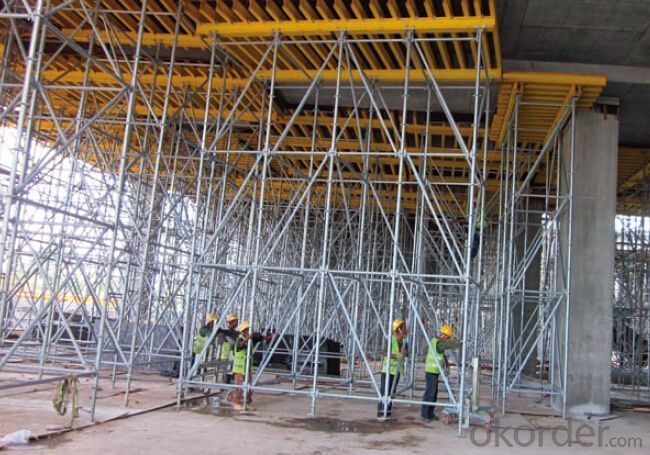
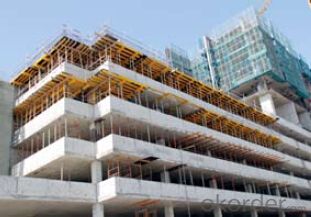
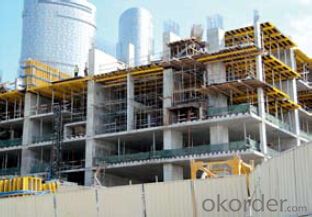
- Q:What are the different finishes available for steel frame formwork?
- Depending on the construction project's specific requirements, there are various finishes available for steel frame formwork. One possibility is a galvanized coating, which involves applying a layer of zinc to the steel surface. This coating is highly resistant to corrosion, making it suitable for projects in harsh environments or those exposed to moisture and chemicals. Additionally, galvanized finishes provide a smooth and uniform appearance, enhancing the formwork's aesthetic appeal. Another option is a powder-coated finish, where a dry powder is electrostatically applied to the steel surface and then cured under heat. This coating offers durability, abrasion resistance, and a wide range of color options. Powder-coated finishes are ideal for projects that require a specific aesthetic or branding. In situations where the steel formwork needs to withstand extreme temperatures or high levels of wear and tear, a fire-resistant or heat-resistant finish may be applied. These finishes are designed to protect against fire, heat, and thermal shock, ensuring the formwork's longevity and safety. Additionally, painted finishes can be used to provide a decorative or protective coating on the steel frame formwork. These finishes can be customized to match the project's color scheme or offer additional corrosion protection. Ultimately, the choice of finish for steel frame formwork will depend on the project's specific needs, including environmental conditions, desired aesthetics, and required performance characteristics. Consulting with a professional is crucial to determine the most suitable finish for a particular construction application.
- Q:What are the environmental impacts of using steel frame formwork?
- Using steel frame formwork has both positive and negative environmental impacts. On the positive side, steel frame formwork is a durable and long-lasting material, allowing for multiple reuses. This reduces the need for frequent replacements and minimizes waste generation in construction projects. Additionally, steel is highly recyclable, so it can be melted down and repurposed at the end of its life cycle, reducing the demand for new steel production and its associated environmental impacts. However, there are also negative environmental impacts associated with steel frame formwork. Steel production requires significant amounts of energy and resources, resulting in greenhouse gas emissions and depletion of natural resources. It also generates substantial waste, including slag and air pollutants, which can harm the environment and human health. Moreover, transporting steel frame formwork materials to construction sites leads to additional carbon emissions and pollution. Due to its weight, steel requires more energy for transportation compared to lighter alternatives. This can significantly increase the environmental footprint of using steel frame formwork, especially for projects located far from steel production facilities. In conclusion, steel frame formwork offers durability and recyclability benefits, but its production, transportation, and associated emissions have negative environmental impacts. To mitigate these impacts, it is essential to consider the overall life cycle assessment of steel frame formwork and explore alternative materials or methods that may have lower environmental footprints.
- Q:Does steel frame formwork require any specific training for installation?
- Yes, steel frame formwork does require specific training for installation. Steel frame formwork is a complex system that involves precise assembling and installation processes. To ensure the safety and effectiveness of the formwork, it is crucial for the installers to have the necessary knowledge and skills. Training for steel frame formwork installation typically includes learning how to read and understand technical drawings and specifications, as well as familiarizing oneself with the different components and materials used in the formwork system. Installers are trained on proper handling, lifting, and positioning of the steel frames, as well as the correct methods for connecting and securing the formwork panels and accessories. Additionally, training covers important safety procedures and measures to be followed during installation, such as the use of personal protective equipment and ensuring stability and stability of the formwork structure. It is also important to understand the load capacities and limitations of the steel frame formwork system to prevent any potential accidents or structural failures. Overall, specific training for steel frame formwork installation is essential to ensure that the formwork is installed correctly, meets the required standards and specifications, and provides a safe and stable support for concrete construction projects.
- Q:Can steel frame formwork be used for both horizontal and vertical reinforcement?
- It is not possible to use steel frame formwork for both horizontal and vertical reinforcement. Steel frame formwork is mainly utilized for vertical reinforcement, such as columns and walls, due to its ability to provide robust support and stability during the concrete pouring and curing process. However, when it comes to horizontal reinforcement like beams and slabs, other formwork systems like timber or aluminum are commonly employed. These formwork systems offer more flexibility and ease of installation for horizontal reinforcement, which typically involves more intricate designs and arrangements.
- Q:Can steel frame formwork be used for both regular and irregular-shaped concrete structures?
- Yes, steel frame formwork can be used for both regular and irregular-shaped concrete structures. Steel frame formwork is highly versatile and can be easily adjusted and customized to accommodate any shape or design requirement. The strength and rigidity of the steel frame provide adequate support and stability, ensuring the formwork can withstand the pressure exerted by the wet concrete during the pouring and curing process. This makes it suitable for constructing various types of concrete structures, including those with irregular shapes and complex geometries. Additionally, steel frame formwork allows for efficient and precise construction, enabling the realization of intricate designs and architectural features. Overall, steel frame formwork is a reliable and adaptable solution for both regular and irregular-shaped concrete structures.
- Q:Can steel frame formwork be used for decorative concrete finishes?
- Indeed, decorative concrete finishes can be achieved through the utilization of steel frame formwork. This adaptable and long-lasting system can be tailored to produce an array of shapes, textures, and patterns on the concrete's surface. The steel frame offers steadfastness and reinforcement for the formwork, guaranteeing the precise and accurate formation of the desired design. Moreover, the steel frame formwork can be effortlessly modified and rearranged to accommodate various decorative components, including patterns, imprints, or textures. Consequently, it is an ideal option for attaining decorative finishes in concrete construction endeavors.
- Q:Can steel frame formwork be used for both standard and customized concrete elements?
- Yes, steel frame formwork can be used for both standard and customized concrete elements. Steel frame formwork is a versatile and flexible system that can be easily adjusted and modified to accommodate various shapes and sizes of concrete elements. It provides a sturdy and reliable support structure for pouring and shaping concrete, ensuring the desired shape, dimensions, and finishes of the concrete elements. Whether it is for standard elements like columns, walls, and slabs, or for more complex and unique designs, steel frame formwork can be customized and adapted to meet specific project requirements. Its strength and durability make it suitable for handling the pressure and weight of concrete during the construction process, while its adjustability allows for precise and accurate construction of both standard and customized concrete elements.
- Q:What are the different types of scaffolding systems used in conjunction with steel frame formwork?
- There are several different types of scaffolding systems that can be used in conjunction with steel frame formwork. These systems are designed to provide a safe and stable platform for workers to access and work on the formwork structure. Some of the most common types of scaffolding systems used in conjunction with steel frame formwork include: 1. Frame Scaffolding: This is the most commonly used type of scaffolding system. It consists of vertical steel tubes connected with horizontal and diagonal braces, forming a frame structure. The frame scaffolding provides a stable platform for workers to access the formwork structure. 2. Tube and Coupler Scaffolding: This system uses steel tubes and couplers to create a modular scaffolding structure. The tubes are connected with couplers, which allow for easy assembly and disassembly of the scaffolding. Tube and coupler scaffolding is highly versatile and can be customized to fit the specific requirements of the formwork structure. 3. Ringlock Scaffolding: This system utilizes a unique rosette connection system, which allows for fast and easy assembly of the scaffolding. Ringlock scaffolding is known for its high load-bearing capacity and stability, making it suitable for supporting heavy formwork structures. 4. Cuplock Scaffolding: Cuplock scaffolding is another popular choice for supporting steel frame formwork. It features a unique locking mechanism that securely holds the scaffolding components together. Cuplock scaffolding is known for its simplicity and versatility, making it a preferred choice for many construction projects. 5. Kwikstage Scaffolding: This system is designed to provide a quick and easy assembly of scaffolding. Kwikstage scaffolding utilizes a wedge connection system, allowing for fast and secure installation. It is a versatile system that can be easily adapted to different formwork structures. These are just a few of the many different types of scaffolding systems that can be used in conjunction with steel frame formwork. The choice of scaffolding system will depend on factors such as the specific requirements of the formwork structure, the load-bearing capacity needed, and the ease of assembly and disassembly. It is important to select the appropriate scaffolding system to ensure the safety and efficiency of the construction project.
- Q:What is the average time required for assembling and disassembling steel frame formwork?
- The time needed for assembling and disassembling steel frame formwork can differ due to several factors, including the structure's size and complexity, the workers' skill level, and the availability of suitable equipment. On average, it typically takes anywhere from 1 to 3 hours to complete this process for a standard construction project. This encompasses tasks like positioning and aligning the frames, connecting the components, and securing them firmly. It's important to bear in mind that this estimate serves as a general guideline, and the actual time required may be either longer or shorter depending on the project's specific requirements and the construction team's efficiency. Additionally, the overall assembly and disassembly time can also be affected by factors such as weather conditions, site accessibility, and coordination with other construction activities.
1. Manufacturer Overview |
|
|---|---|
| Location | |
| Year Established | |
| Annual Output Value | |
| Main Markets | |
| Company Certifications | |
2. Manufacturer Certificates |
|
|---|---|
| a) Certification Name | |
| Range | |
| Reference | |
| Validity Period | |
3. Manufacturer Capability |
|
|---|---|
| a)Trade Capacity | |
| Nearest Port | |
| Export Percentage | |
| No.of Employees in Trade Department | |
| Language Spoken: | |
| b)Factory Information | |
| Factory Size: | |
| No. of Production Lines | |
| Contract Manufacturing | |
| Product Price Range | |
Send your message to us
Table formwork system for Build
- Loading Port:
- China Main Port
- Payment Terms:
- TT OR LC
- Min Order Qty:
- -
- Supply Capability:
- -
OKorder Service Pledge
Quality Product, Order Online Tracking, Timely Delivery
OKorder Financial Service
Credit Rating, Credit Services, Credit Purchasing
Similar products
New products
Hot products
Related keywords



















